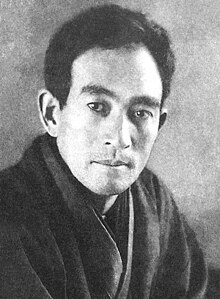Shiga Naoya
Shiga Naoya ( Japanese 志 賀 直 哉 ; born February 20, 1883 in Ishinomaki in the Japanese prefecture of Miyagi ; † October 21, 1971 in Atami in the Japanese prefecture of Shizuoka ) is one of the most important Japanese writers of the 20th century.
Life
Shiga Naoya was born into a wealthy, upper-class business family with a samurai tradition . His father's patriarchal and at the same time ruthless entrepreneurial views challenged the son's resistance at an early stage and led to long-term disputes that would later find expression in the work of the young author. From 1889 to 1906 Shiga attended the elite Gakushuin , at the time a high school for the aristocracy and the upper classes. He then studied English literature at the Imperial University of Tokyo , which he left four years later. He then worked exclusively as a writer. He was a co-founder of the literature magazine Shirakaba ( White Birch ), which appeared from 1910.
In 1949 Shiga was awarded the Order of Culture .
plant
When the great powers reached Japan , which had long been closed to foreigners, in the middle of the 19th century , the Japanese were forced to open up to European culture and to familiarize themselves with it literarily. The first transcriptions of European works appeared around 1860, and the first complete novel from the West was translated into Japanese in 1878. The essence of the novel (Shosetsu Shinzui) by Tsubouchi Shōyō (1859-1935), the first critical work of modern Japanese literature , appeared in 1885 .
At the turn of the century, French naturalism invaded Japan. In contrast to European naturalism , the Japanese are characterized by their passion for confession. At the beginning of the 20th century, people were tired of the skepticism , passion and the dark side of life that heightened naturalism brought with it.
In response to the realistic school, the literary circle of friends of the Shirakaba School was created in 1910 , to which Naoya Shiga also belonged. Shirakaba magazine gave its name to a major movement inspired by an idealistic form of humanism . The authors gathered there around Natsume Sōseki taught that life is bright and happy when people understand how to enjoy themselves. Peace and tranquility were praised. The young Shirakaba writers were strongly influenced by the humanism of Tolstoy and Dostoyevsky .
In Shiga first writings, his rings reflect to enforce its individuality against the constraints of family and society and resist, the search for a new ethics beyond the ruling, on traditional ancestor worship based ideology of Tennō -Verehrung. Self-destruction and crime appear to be the ultimate consequence of uncompromising self-assertion in the face of an environment that denied individual development.
A four-year career break and Shiga's reconciliation with his father marked a turning point in his work. In his works, which were created from 1917, he avoided any confrontation. It has been replaced by the pursuit of harmony , which is deeply rooted in traditional Japanese thinking , as an essential aspect of the search for a fulfilled life.
Shiga wrote short stories , short stories, and novels . They tell of their own experiences, his most important works are autobiographical. With sure intuition he hits the essentials and presents it with convincing simplicity. The transience of life symbolized in the cycle of nature and the struggle of the individual for self-realization are the central themes of his work. Stylistic brilliance and subtle perception characterize the short stories and sketches that reflect Shiga's humanistic idea of the human being freed from social deformation and striving for individual development and inner harmony.
Shiga is considered a classic of modern Japanese short prose because of its clear style .
“Shiga Naoya was one of the first to create a literary style that could convincingly and precisely express the quirks of modern Japanese thinking and feeling ... Only a creative writer like Shiga could turn the incoherent elements of the Japanese language into a literary tool forge that is suitable for a true, detailed, description of life as it unfolds around us. "
Works (selection)
- Das Rasiermesser (Novelle, 1910), German in: Blood in the Dawn , ed. v. van de Wetering. Rowohlt 1994. ISBN 3-499-43075-4
- The crime of Han (novella, 1913), German in: Japan told , ed. v. M. Donath. Fischer 1991. ISBN 3-596-10162-X
- A peaceful couple (novella, 1917)
- In Kinosaki (novella, 1917)
- Manazuru (Novelle, 1920), German in: Moon on Water , ed. v. M. Brettschneider. People & World 1978.
- Campfire (novella, 1920)
- The rebirth (novella, 1924)
- The way through dark night (novel, 1921–1937)
- Journey in early spring (novella, 1941)
- The Ashen Moon (Novella, 1946)
- Herbstwind (novella, 1949)
Many of Shiga Naoya's stories have been collected in the volume Memory of Yamashina (People & World 1986).
literature
- Oscar Benl (Ed.): A bell in Fukagawa , Herrenalb: Horst Erdmann Verlag 1964.
- Ivan Morris (Ed.): Nippon , Zurich: Diogenes Verlag 1965.
- Marianne Bretschneider (Ed.): Mond auf dem Wasser , Berlin: Verlag Volk und Welt 1972.
- Edith Rau (Ed.): Memory of Yamashina , Berlin: Verlag Volk und Welt 1986.
- Donald Keene : Japanese Literature , Zurich: Orell Füssli Verlag 1962 (original title: Japanese Literature, John Murray, London 1953).
Web links
| personal data | |
|---|---|
| SURNAME | Shiga Naoya |
| ALTERNATIVE NAMES | 志 賀 直 哉 (Japanese) |
| BRIEF DESCRIPTION | Japanese writer |
| DATE OF BIRTH | February 20, 1883 |
| PLACE OF BIRTH | Ishinomaki |
| DATE OF DEATH | October 21, 1971 |
| Place of death | Atami |

